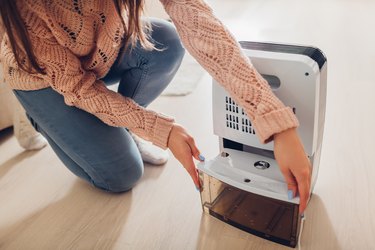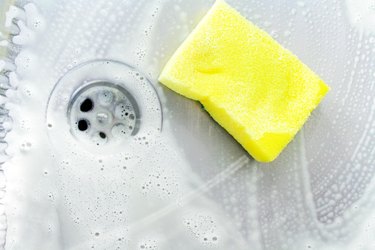
Ask any allergist, and they'll tell you: Excessively damp, humid air in your home is unhealthy.
"Anything above about 60 percent provides the perfect atmosphere for both mold and dust mites to thrive, which can cause a stuffy nose, eye irritation, sneezing, coughing and even wheezing," says Janna Tuck, MD, a spokesperson for the American College of Allergy, Asthma and Immunology and an allergist in Santa Fe, New Mexico.
Video of the Day
Video of the Day
Too much moisture can also cause issues in your house, including warping or cracking wood furnishing and floors, encouraging the growth of mold and mildew on carpets and allowing rust to accumulate on your toilet tanks and water pipes. A dehumidifier can help you reduce the dampness in the air, but it's only effective if you use it properly. Here, five mistakes not to make with your dehumidifier, plus what to keep in mind before making a purchase.
1. You Don’t Set the Right Humidity Level
The optimal relative humidity level is between 30 and 50 percent, Dr. Tuck says. Aim for 30 to 40 percent in colder areas during heating season.
If the humidity is higher than that, it can breed dust mites, mildew and mold and trigger allergies. Keep in mind, it's also important to make sure the humidity in your home doesn't dip too low — that can lead to dry skin, itchy eyes and other allergy-like symptoms, per the Mayo Clinic.
The best way to control your humidity in the home is by monitoring humidity levels through a reliable HVAC thermostat, says Anthony Carrino, celebrity home improvement expert and Trane Residential partner. You can purchase one at a home improvement store, and they range in cost from around $50 to $300.
Tip
A cheaper option is a hygrometer, which you can buy for as little as ten dollars online or at your local drugstore. Dr. Tuck has several in various spots of her house so she can routinely check her humidity levels.
2. You Don’t Pick the Right Spot or Size
The basement is usually ideal for a dehumidifier because the humidity there tends to be the highest. "If you can reduce it there, then you can usually reduce it through your whole home," Dr. Tuck says. Another reason why the basement is a good idea is it usually has a drain, so that you can empty the dehumidifier easily.
"You don't want water to just sit there, since that in itself can breed mold, which can trigger allergies and other respiratory problems," Dr. Tuck says.
Tip
To empty a dehumidifier, find the drain port on the back of the unit, unscrew the drain plug, then attach a hose and let it drip directly into the basement drain.
If you do opt to put your dehumidifier in the kitchen or bathroom, place your hygrometer elsewhere, since temporary moistness from cooking or showering can make it appear that your house has higher humidity than it actually does, Dr. Tuck says. This in turn can over-dry your house, which can parch your own skin, hair, eyes, and even your nose and throat, actually making you more susceptible to respiratory problems.
Most portable dehumidifiers have top-mounted air discharge and can be placed against walls, but if yours doesn't, make sure you place it away from walls and furniture, so that air can circulate freely around the unit.
3. You Leave Windows and Doors Open

Enclosing the space allows your dehumidifier to work more efficiently.
"If your dehumidifier is in your basement and you leave a window to the outside open in a region with high humidity, all you're doing is pulling outside water into the house, which won't help you at all," Dr. Tuck says. It also allows outdoor allergens such as pollen or mold to trickle in.
4. You Don’t Empty It Regularly
Most portable dehumidifiers use a removable plastic bucket and warning lights to indicate when the bucket is full and needs to be emptied.
There's typically an automatic shutoff when the bucket is full, so you won't have to worry about the bucket overflowing, Dr. Tuck says. But if the water in the bucket is left for a long period of time, it could cause mold to start growing on your dehumidifier. This could trigger an allergic reaction, or, even if you don't have allergies, irritate your lungs, Dr. Tuck says.
If you have trouble remembering, consider buying a dehumidifier that comes with a fitting that allows you to hook a hose directly to the bucket. This can then be directed into a floor drain or sump pump, so there is no need to empty it.
5. You Don’t Clean It Often Enough

While your dehumidifier sucks moisture from the air, it's also pulling in things like mold, mildew, bacteria, pollen and dust, which means it's a must to keep it clean. Aim to clean it weekly, recommends the Mayo Clinic.
Most new models have an indicator light to tell you when it is time to scrub it down. Follow the manufacturer's advice that's in your owners' manual.
But don't forget to unplug it, advises Dr. Tuck, and to clean out all its parts — the dehumidifier bucket, the air filter and the bucket filter, with soap and warm water. This is because the moisture from the air can start to build up inside of them, which can encourage the growth of mold. Let it air dry before starting up again, and if you can, vacuum out any residual grime with your vacuum's small attachment.
Before You Buy a Dehumidifier
Before you make a purchase, keep these three considerations in mind:
1. Look for an Energy-Friendly Model
You can expect to pay about $10 to $15 a month to run a typical residential model, with many eating up over 1,000 kWh of energy a year, says Shane Dutka, founder and general manager of Review Home Warranties, a website with information for homeowners on home warranties. But you can slash electricity use — and cost — by investing in an Energy Star model.
These models must meet certain guidelines to get an energy-friendly seal of approval, per the Energy Star program, which is run by the U.S. Department of Energy and the U.S. Environmental Protection Agency. For dehumidifiers, that means they use more efficient refrigeration coils, compressors and fans to remove the same amount of moisture as a similarly sized conventional unit but use nearly 15 percent less energy.
2. Measure Your Space
You'll want to get a dehumidifier that's the right size for the room, so make sure to measure the space. A damp room that's under 1500 square feet usually only needs a 30-pint dehumidifier, while a larger one may require a 50 or even a 70 pint.
Tip
When in doubt, go with the larger size, since you can run it on a lower setting and thus reduce electricity usage and bring down your energy bills.
3. Make Fixes to Cut Down on Moisture
Even the most efficient dehumidifier won't work well if you've got too much outside moisture seeping into your house. Try making the following simple home improvements, per Energy Star:
- Extending downspouts from your gutters away from your home foundation, and make sure both are clear and open.
- Make sure your clothes dryer is properly vented to the outdoors.
- Repair any leaking outdoor faucets.
- Use vent fans in your kitchen and bathrooms.
- If your house has central AC, install an AC vent in the most humid space of your home (usually your basement). This will help dehumidify, and improve airflow between the most humid parts of your home and the drier parts.
Dehumidifiers to Buy
- hOmeLabs 3,000 Sq. Ft Energy Star Dehumidifier ($249.49, Amazon)
- Honeywell, White TP30WKN Energy Star Dehumidifier ($199.99, Amazon)
- Frigidaire 70-Pint 2-Speed Dehumidifier ($329.99, Lowes)
Is this an emergency? If you are experiencing serious medical symptoms, please see the National Library of Medicine’s list of signs you need emergency medical attention or call 911.